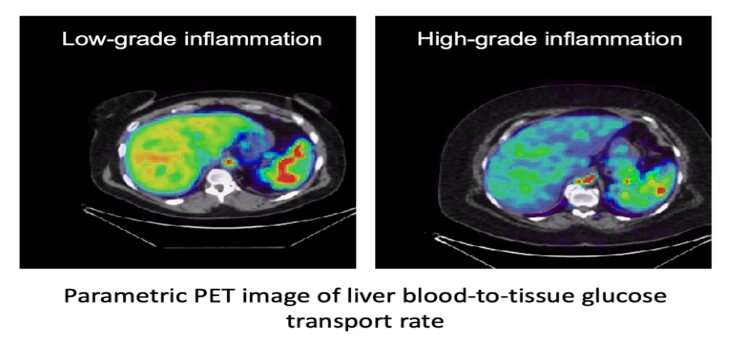New PET imaging-based tool detects liver inflammation from fatty liver disease

A UC Davis Health team has developed a first-of-its-kind positron emission tomography (PET) scan imaging-based tool to detect liver inflammation in patients affected with non-alcoholic fatty liver disease.
Many patients diagnosed with the disease develop nonalcoholic steatohepatitis (NASH), which is characterized by liver inflammation and scarring or fibrosis and can progress to liver cirrhosis and increase the risk for liver cancer.
"Nonalcoholic fatty liver disease is one of the fastest-growing causes of liver cancer around the world. It's also driving an increase in the need for liver transplantation," said Souvik Sarkar, associate professor of Gastroenterology and Hepatology and director of fellow research at UC Davis Health. "Currently, there are very limited tools to detect liver inflammation in patients other than invasive liver biopsy. So, establishing new methodologies for early screening for patients could lower their risks for developing new diseases."
In the United States, nearly a third of the population has been diagnosed with nonalcoholic fatty liver disease. Currently, there are no FDA-approved drugs to treat NASH, but there are several drugs currently being tested in clinical trials. The first line of treatment for fatty liver disease is lifestyle modification, including weight loss, diabetes management, and exercise.
"The liver is a resilient organ that has shown a remarkable ability to heal itself once the underlying reason for disease is removed," said Souvik.
The one-of-a-kind method uses dynamic PET imaging and mathematical modeling to measure the rate of glucose transport from blood to liver tissue. This correlates with the widely used grades, or levels, of liver inflammation. The groundbreaking technique allows clinicians to quantify liver inflammation.
"It is exciting to see that our methodology can fill the gap in clinical imaging of nonalcoholic fatty liver disease," said Guobao Wang, associate professor of Radiology at UC Davis Health. "This collaboration has been extremely fruitful, as our team has been working diligently to develop this technique."
The team is also developing an integrated PET and computed tomography- (CT) based imaging method for liver fat measurement and fibrosis assessment. The effort could allow a "one-stop-shop" tool for nonalcoholic fatty liver disease diagnosis using any commercial PET/CT scanner. This methodology will also be applied as part of multi-organ imaging using the state-of-the-art EXPLORER total-body PET scanner at UC Davis.
Souvik and Wang, along with colleagues Michael T. Corwin, Ramsey D. Badawi, Karen E. Matsukuma, Kristin A. Olson, and Shuai Chen, have been collaborating on this project for the last five years. They received the UC Davis Health Collaboration for Diagnostic Innovation grant and a new $2.15 million National Institutes of Health grant.
The team recently reported the first PET/CT results for diagnosing NASH in the journal Clinical Gastroenterology and Hepatology and previously published the first PET results in the American Journal of Roentgenology, as well as the imaging and modeling methods in Physics in Medicine and Biology. The team has filed for a patent and it is currently pending.
More information: Souvik Sarkar et al, Dynamic Positron Emission Tomography/Computed Tomography Imaging Correlate of Nonalcoholic Steatohepatitis, Clinical Gastroenterology and Hepatology (2020). DOI: 10.1016/j.cgh.2020.10.029





















